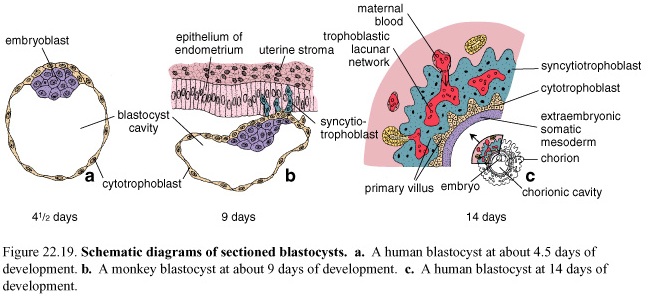
- •Cytology
- •The cell
- •Plasma membrane or plasmalemma
- •Intercellular connections
- •The membranous organelles Endoplasmic reticulum (e. R.)
- •Rough e. R. (rEr)
- •Smooth e. R. (sEr)
- •Golgi apparatus
- •Lysosomes
- •Peroxisomes (microbodies)
- •Mitochondria
- •Microtubules
- •Cilia and flagella
- •Filaments
- •Inclusions
- •Nucleus
- •Chromatin
- •Nucleolus
- •Nucleoplasm
- •Cell cycle
- •Mitosis
- •Embryology
- •The spermatozoon
- •Ovums or ovocytes
- •Fertilization
- •Penetration of Zona Pellucida
- •Fusion of Pronuclei
- •Cleavage
- •Blastocyst Formation Compaction
- •Cavitation
- •Gastrulation
- •Human developmental periods
- •Progenesis
- •Derivations of the ectoderm
- •Derivations of the mesoderm
- •Derivations of the endoderm
- •Fetal membranes
- •Placenta
- •Placental barrier
- •Umbilical cord
- •Amniotic fluid
- •Tissues
- •Classification of epithelium
- •Functions of a blood
- •Red blood cells
- •White blood cells
- •Neutrophils
- •Eosinophils
- •Basophils
- •Lymphocytes
- •Monocytes
- •Platelets
- •Hematopoiesis
- •Hematopoiesis in embryonic and fetal life
- •Pluripotential hematopoietic stem cells
- •Connective tissue
- •Loose connective tissue
- •Dense connective tissue
- •Connective tissue (c.T.) with special properties
- •Brown adipose c.T.:
- •Connective tissue fibers
- •Collagen fibers
- •Reticular fibers
- •Elastic fibers
- •Ground substance
- •Connective tissue cells
- •Fibroblasts and myofibroblasts
- •Macrophages
- •Mast cells
- •Hyaline cartilage
- •Fibro cartilage
- •Bone cells Osteoblasts
- •Osteocytes
- •Osteoclast
- •Classification of bone tissue
- •General structures of bones
- •Cartilage Arises From Mesenchyme
- •Bone formation
- •Intramembranous Ossification
- •In Intramembranous Ossification, Bone Is Formed by Differentiation of Mesenchymal Cells Into Osteoblasts
- •Endochondral Ossification
- •Growth of Endochondral Bone
- •Muscle tissue
- •Classification of muscle
- •Skeletal muscle
- •Skeletal muscle fibers
- •Myofibrils and myofilaments
- •Organization of a skeletal muscle
- •Cardiac muscle
- •Smooth muscle
- •Contraction and its control
- •Nervous tissue
- •Dendrites and axons
- •Synapses
- •Axonal transport systems
- •N euroglia
- •Functions of neuroglia
- •Schwann cells and the myelin sheath
- •Literature
Penetration of Zona Pellucida
Once inside the corona radiata, the sperm binds to the species-specific ZP3 receptor on the egg’s glycoprotein coat. This triggers the acrosomal reaction, or the release of enzymes stored in the sperm’s acrosome (e.g. acrosin). These enzymes help the sperm “drill through” the zona pellucida.
Once the sperm has penetrated the outer layers it fuses with the plasma membrane of the egg and releases its contents inside. The head and the tail of the sperm degrade, so that all mitochondria in the embryo (and all mitochondrial DNA) come from the mother. The touch of spermatozoon to an ovum surface causes reciprocal changes in a boundary layer of ovoplasma.
The third phase of fertilization begins.
Entry of a sperm into the egg causes changes that prevent polyspermy (fertilization of an egg by more than one sperm). These changes are known as the cortical reaction. Cortical granules move to a surface of a plasmatic membrane and their contents secretes in the space environmental ovum.
Fusion of Pronuclei
In ovoplasma the spermatozoon head turns on 180 degrees, approximated and turns in male pronucleus. The ovum nucleus turns in female pronucleus. The male and female pronuclei fuse and make a synkaryon. The fertilized egg is called zygote (“together”).
Cleavage
The zygote undergoes a number of ordinary mitotic divisions that increase the number of cells in the zygote but not its overall size. Each cycle of division takes about 24 hours. The individual cells are known as blastomeres. At the 32-cell stage the embryo is known as a morula (L. “mulberry”), a solid ball consisting of an inner cell mass and an outer cell mass. The inner cell mass will eventually become the embryo and fetus, while the outer cell mass will eventually become part of the placenta.
Blastocyst Formation Compaction
The cells on the outside of the morula form tight intercellular junctions and express ion channels to create an impermeable barrier.
Cavitation
A fluid-filled cavity forms inside the morula. This cavity is known as the blastocyst cavity or blastocoele, and the morula is now called a blastula or blastocyst. The inner cell mass is now known as the embryoblast and the outer cell mass becomes the trophoblast.
Figure 8. Schematic diagrams of sectioned blastocysts. a. A human blastocyst at about 4, 5 days of development. b. A monkey blastocyst at about 9 days of development. c. A human blastocyst at 14 days of development

Human cleavage is called:
-complete
-asynchronous
-nearly equal
Implantation
Hatching
The blastula sheds its zona pellucida. This is required for implantation to occur. One function of the zona pellucida is to prevent premature implantation.
Attachment and Invasion
The embryo attaches to and invades into the maternal endometrium. The trophoblast differentiates into the cytotrophoblast and the syncytiotrophoblast. The embryo typically implants in the posterior superior wall of the uterus. The response of the maternal endometrial cells to the invading embryo is called the decidual reaction.
